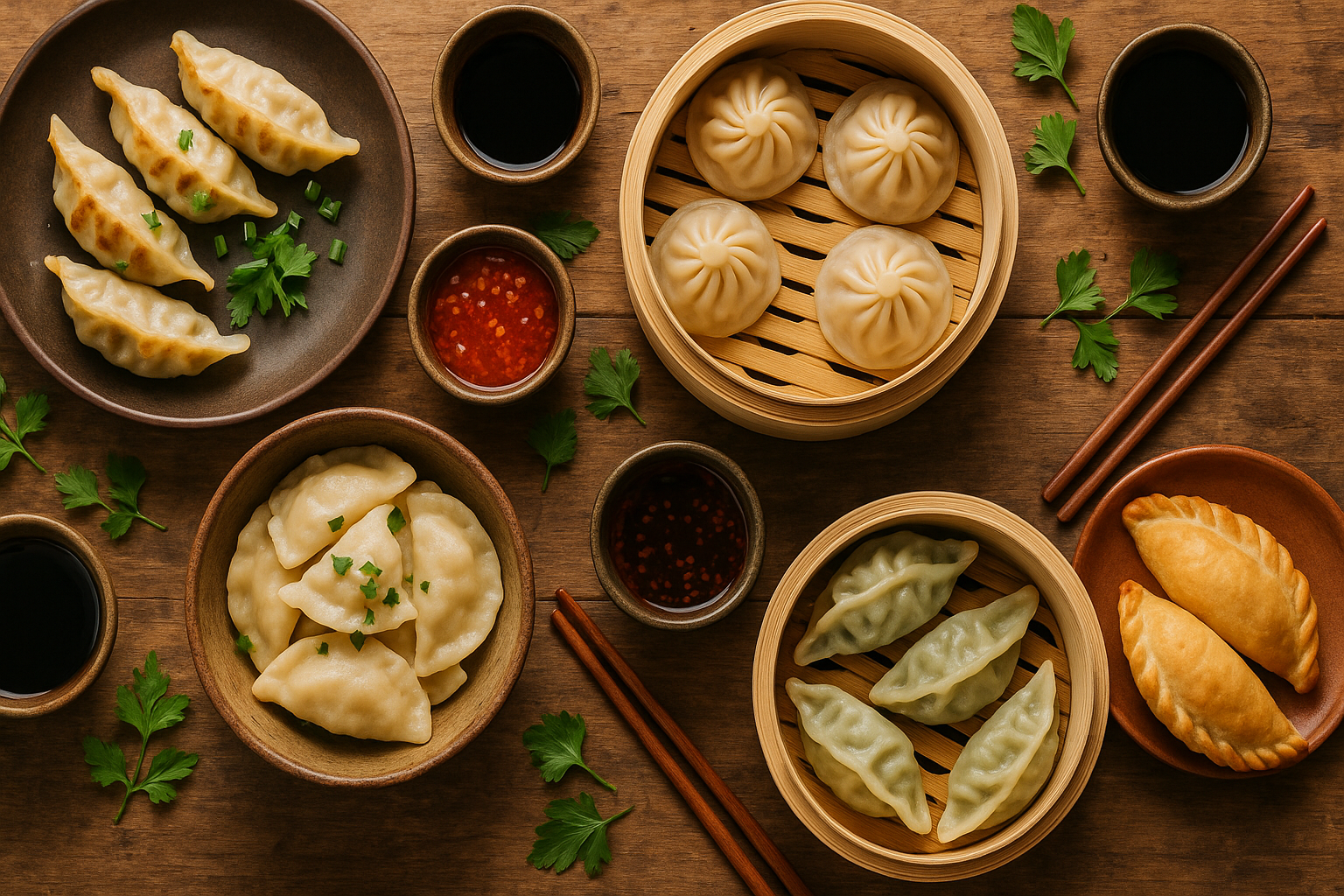The First Bite
It started in a small kitchen in Melbourne — steam fogging the windows, the sound of sizzling oil, and the faint scent of soy, ginger, and something nostalgic. I was folding dumplings with my grandmother, her hands moving faster than I could follow.
She looked up, smiled, and said, “Every culture has its dumpling. You just have to find it.”
That night, between pleats and laughter, I realized she was right. Dumplings aren’t just food — they’re a world language spoken through dough.
(Related reading: The Ultimate Guide to Dumpling Styles Around the World)
1. Japanese Gyoza — The Golden Crisp
In Tokyo, late-night izakayas hum with conversation as plates of gyoza arrive — perfectly golden, thin-skinned, and fragrant with garlic.
The filling? A balanced mix of minced pork, cabbage, and chives — juicy inside, crispy outside.
To get that restaurant-quality crunch at home, the secret lies in the “steam-fry” method. Learn how to nail it in How to Make Perfect Dumplings.
2. Korean Kimchi Mandu — Fire and Fermentation
When winter settles over Seoul, kitchens fill with the warmth of kimchi mandu — fiery, tangy dumplings that wake the senses.
Each bite bursts with the punch of fermented cabbage, tofu, and sesame oil — a reminder that fermentation isn’t just flavor, it’s life.
3. Chinese Xiao Long Bao — The Soup Symphony
Imagine lifting a dumpling gently from your spoon, biting carefully — and a burst of hot, savory broth fills your mouth. That’s the magic of Shanghai’s Xiao Long Bao.
It’s equal parts art and science: gelatinized stock, thin wrappers, perfect timing. A single tear in the skin ruins the performance, so handle with love.
(Bonus: Learn more about balancing fillings and textures in Are Your Dumplings Good for You? A Complete Health and Nutrition Guide.)
4. Polish Pierogi — Nostalgia on a Plate
In Kraków, dumplings don’t just feed you — they tell stories.
Potato and cheese pierogi are kneaded by hand, boiled gently, and served with butter and caramelized onions. They taste like Sunday afternoons, family chatter, and soft snow outside.
Try swapping traditional cheese with mashed pumpkin or sweet potato for a lighter, seasonal twist.
5. Russian Pelmeni — The Siberian Survivor
Pelmeni were born in the frost. Hunters once carried them frozen in packs, ready to boil over fire in the wilderness.
Today, they’re comfort food — small, sturdy, filled with minced beef or mushrooms, and dipped in sour cream.
If dumplings had a motto, pelmeni’s would be “simple, strong, and made to last.”
6. Georgian Khinkali — The Twist of Tradition
Somewhere in the Caucasus, laughter echoes as people compete to eat khinkali without spilling a drop of broth.
Spiced meat, coriander, and pepper sit inside thick dough — twisted elegantly at the top like a pouch of secrets.
You bite, sip, and smile — one fold at a time.
7. Argentinian Empanadas — A Street Food Embrace
Walk the streets of Buenos Aires and you’ll smell empanadas baking — buttery crusts, beef simmered with onion and paprika.
Technically baked, not boiled, but spiritually dumplings nonetheless. Each fold holds centuries of migration, memory, and spice.
8. Mexican Tamales — The Heart of Maize
In Mexico, dumplings wear corn husks instead of dough. Tamales — corn masa stuffed with mole, beans, or cheese — are steamed in bundles and shared during celebrations.
Gluten-free by nature, they’re a reminder that dumplings adapt — always finding a way to fit every culture, every diet.
9. Italian Ravioli — Pasta’s Soft-Spoken Cousin
Some say ravioli are just pasta. But when you watch them being pressed by hand, dough folding over ricotta or spinach, you realize — they’re dumplings in disguise.
In Italy, they’re served simply, with butter and sage, proof that elegance can come from restraint.
10. Fusion Dumplings — The Future in a Fold
In modern kitchens, imagination takes over.
Kimchi-cheese gyoza. Truffle mushroom wontons. Thai curry-filled potstickers.
Each one bridges tradition and innovation — the old and the new sitting side by side on a plate.
(Tip: Explore healthy variations and cooking methods in Are Your Dumplings Good for You?)
A World Wrapped in Dough
Every culture has its dumpling because every culture understands comfort. It’s food that feels like home — no matter where that home is.
The next time you fold one, remember: you’re not just wrapping ingredients. You’re wrapping history, migration, and memory — a small story that belongs to everyone.
For expert folding, sealing, and cooking tips, revisit How to Make Perfect Dumplings — and make your next dumpling session an adventure across continents.
Popular fillings include pork and cabbage (China, Japan), potato and cheese (Poland), kimchi and tofu (Korea), and beef with onions (Argentina). Every region has its unique twist!
Yes. Choose lean proteins, whole-grain wrappers, and steam or boil instead of deep-frying. Read our full guide: Are Your Dumplings Good for You? A Complete Health and Nutrition Guide
They’re all types of dumplings but differ in wrapper thickness, filling, and cooking style. The Ultimate Guide to Dumpling Styles Around the World explains this beautifully.
Steaming retains nutrients and gives a tender texture; pan-frying adds crispness; boiling works for broth-based versions. Learn tips from How to Make Perfect Dumplings.
Yes! Place uncooked dumplings on a tray, freeze until solid, then store in bags. Cook from frozen — no thawing needed.
Classic soy-vinegar, chili oil, or sesame dipping sauces are perfect. You can also experiment with ponzu, peanut, or miso-based blends.
